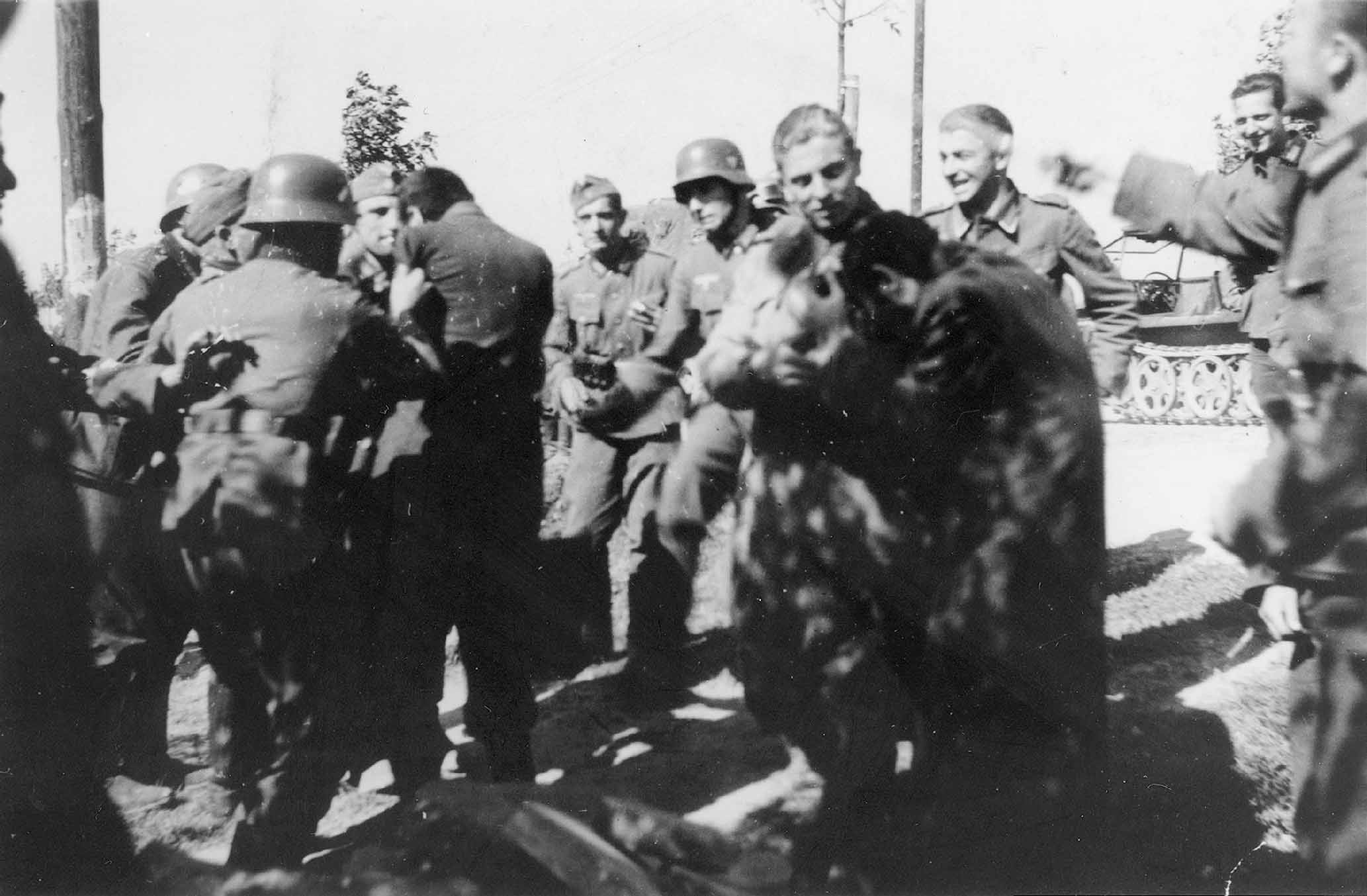
German soldiers beat Polish Jews in the vicinity of Łódź during the invasion of Poland. The persecution of the Jews of Poland began almost immediately after the German invasion. (USHMM: Mary Jane Farley)
Designated areas of larger Polish cities were outlined in a massive programme of ghettoization. The programme was headed by Hans Frank who became Governor General of the occupied Polish territories with responsibility for the administration of the General Government. It was he who put into action the segregation of the Jews and their ‘ghettoization’.
Frank’s plan was to uproot all Polish Jews from their homes and businesses through compulsory expulsions. Entire Jewish communities were to be deported by train from their places of origin into special closed-off zones using Order Police Battalions. These battalions were subordinated to the SS and deployed specifically in army group rear areas and territories under German civilian administration. The police units were given strict orders to target the civilian population throughout the General Government and specifically to carry out the expulsion of Poles from the Reichsgau Wartheland under the new Lebensraum policies. They were told to be as brutal as necessary to expedite what they referred to as ‘Resettlement Actions’.
The Police Battalions, often supported by army units, moved into selected areas and removed the local population from their flats and houses, confiscating them. These areas were then marked off to become separated from the rest of society. Between late 1939 and 1940 there were also expulsions from German-occupied ‘Greater Poland’. Some 680,000 Poles were expelled from the city of Poznanό in Reichsgau Wartheland alone, of whom approximately 70,000 were moved into the General Government. These deportations were conducted under the leadership of SS-Obergruppenfu¨hrer Wilhelm Koppe.
The first deportations of the Jewish community into the newly-created ghetto system began in October 1939. All Jewish homes and businesses were vacated through forcible expulsions in a very short period of time. On the day of their removal notice, Jews received orders to present themselves at special assembly points so that they could be ‘evacuated further east’. Each person was issued with an evacuation number – a number which would give the authorities details of where they would be transported. So as not to create panic, the deportees were allowed to take 50kg of luggage. They also had to pay for their own railway tickets.
The first major transports began with the removal of some 70,000 to 80,000 Jews from Ostrava district in Moravia (now in eastern Czech Republic) and in Katowice district in the recently annexed portion of Poland. SS-Obersturmfu¨hrer Adolf Eichmann was tasked with managing the logistics of the mass deportation of Jews to the ghettos from these areas, and later to the extermination camps. His priority in 1939 was to remove Jews from the conquered territory of Greater Poland and transport them into the General Government economically and with minimal disruption to Germany’s ongoing military operations. By the end of 1941 some 3.5 million Polish Jews had been segregated and ghettoized by Eichmann in his massive deportation action involving the use of hundreds of freight trains.
In October 1941 the first transports of German Jews were sent by rail to either labour camps in Poland or the General Government to be ghettoized. The freight cars (Gu¨terwagen) were packed with 150 deportees, although 50 was the number initially proposed by deportation regulations. There was no food or water. An average transport took four days. Many died from hunger or exposure to the elements, and inadequate ventilation resulted in many deaths from suffocation. Often when the trains arrived at their destination and the doors were opened, everyone was dead.
Those that had survived the journey were removed from the trains under armed guard and either marched on foot or transported by vehicle to the ghetto. Even as they arrived inside the ghetto, many still believed this was only a stopover on the way to their new lives further east. They had no idea that they would soon see their ghettos destroyed, often barbarically, and that they would be forced into nearby forests or fields to be murdered, or be transported either to labour camps or death camps around Europe.

German soldiers beat Polish Jews in the vicinity of Łódź during the invasion of Poland. The persecution of the Jews of Poland began almost immediately after the German invasion. (USHMM: Mary Jane Farley)
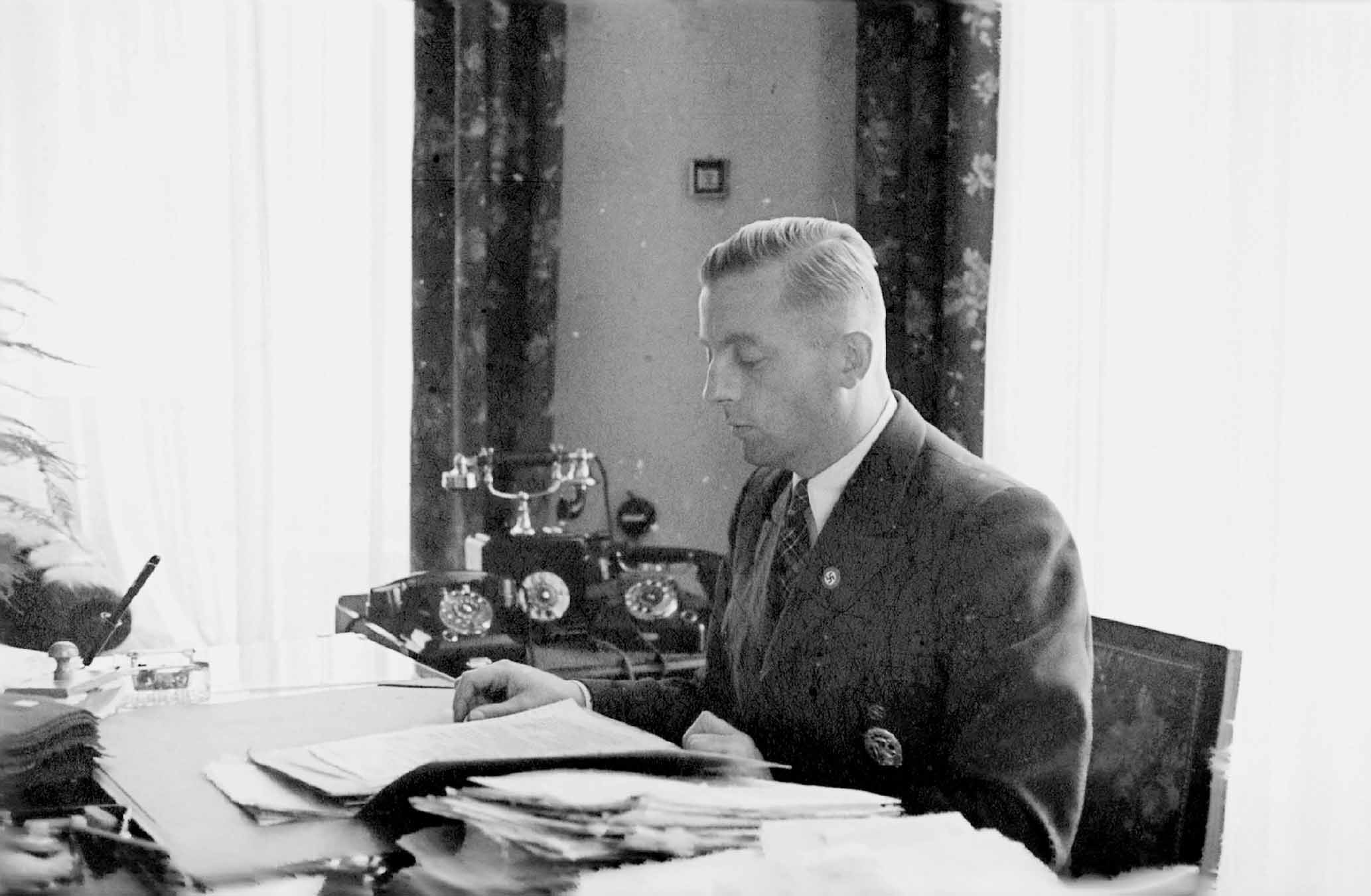
Hans Biebow, German head of the Łódź ghetto administration, at his desk. Under his administration, and with the help of Adolf Eichmann, he moved 164,000 Jews to Poland’s second largest city, Łódź. Communication between the ghetto inhabitants and the outside world was completely cut off and the supply of food was severely limited, with the result that many of the inhabitants of the ghetto would starve to death. He was also responsible for assisting the Gestapo and other police authorities rounding up Jews during deportations. (USHMM: Robert Abrams)
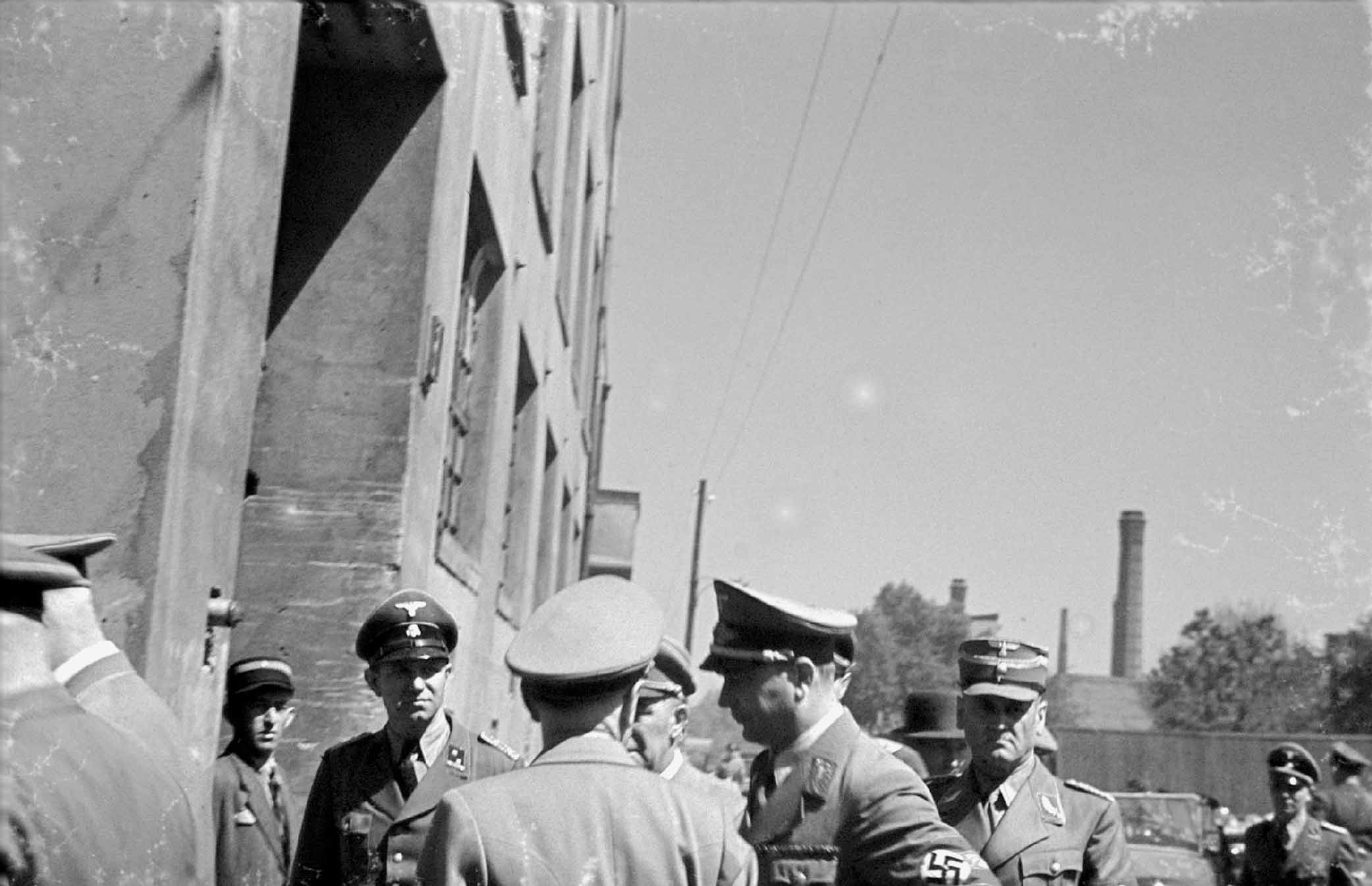
Gauleiters attend a meeting in the Łódź ghetto in 1941. Pictured is Arthur Greiser and Wilhelm Frick. Greiser was Reichsstatthalter (Reich governor) of the German-occupied territory of Wartheland and was one of those primarily responsible for organising the transportation from his domain to the ghettos in Poland and later responsible for the Jews being moved to their deaths in the concentration camps. Frick was Protector of Bohemia and Moravia and was a ruthless individual. He assisted in the transportation of Jews from the Czech region to the concentration camps. (USHMM: Robert Abrams)
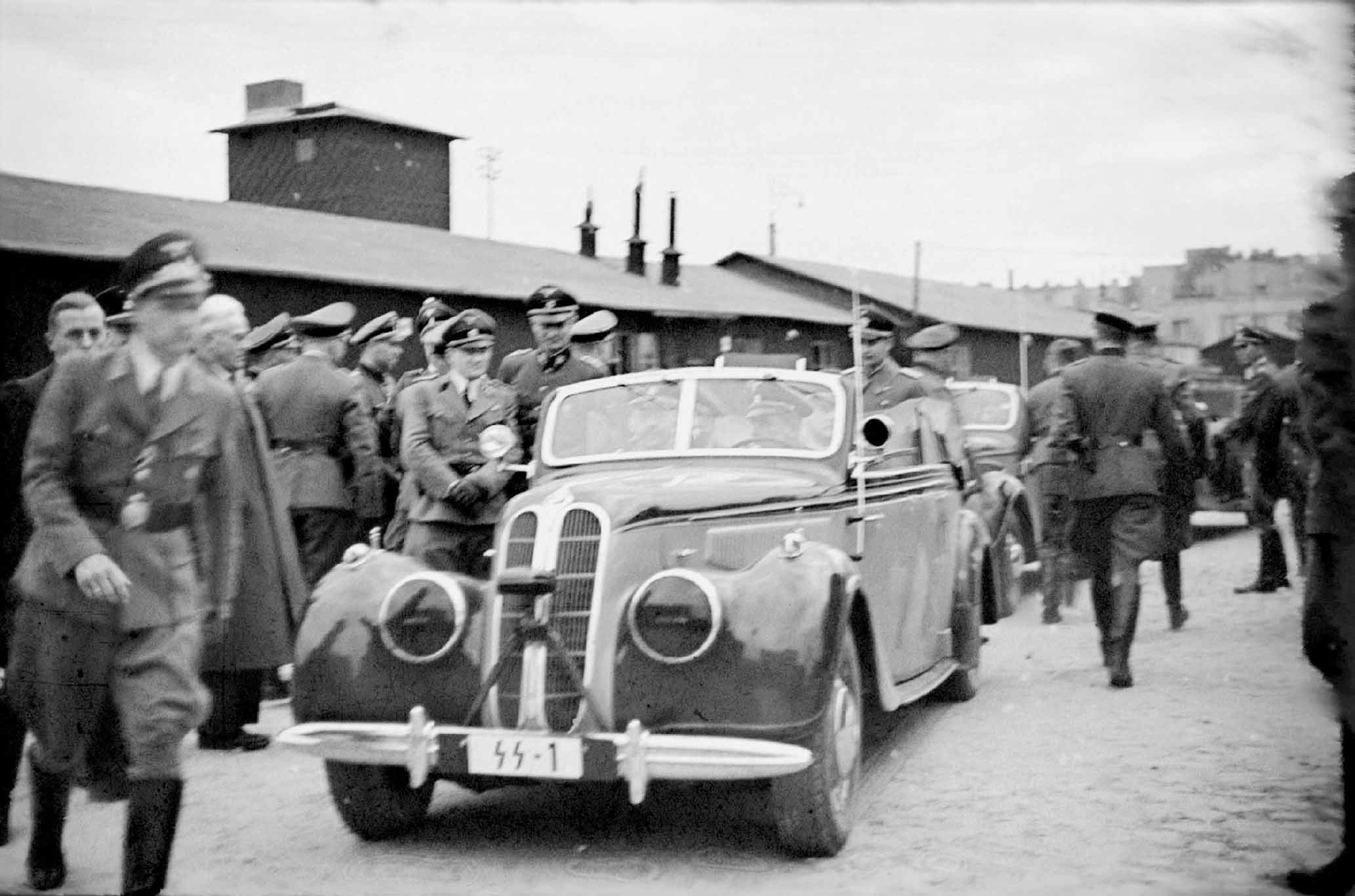
An official visit of Heinrich Himmler to the Łódź ghetto. Mordechai Chaim Rumkowski, head of the Jewish council, greets the Nazi officials. Standing to the right of the car is Karl Wolff, Chief of Personal Staff to Himmler. He was responsible for ordering the deportation of all male Jews of Polish nationality and their families to the ghettos. Later in 1942 he oversaw the liquidation of the Warsaw ghetto and the Jews’ mass extermination. (USHMM: Robert Abrams)
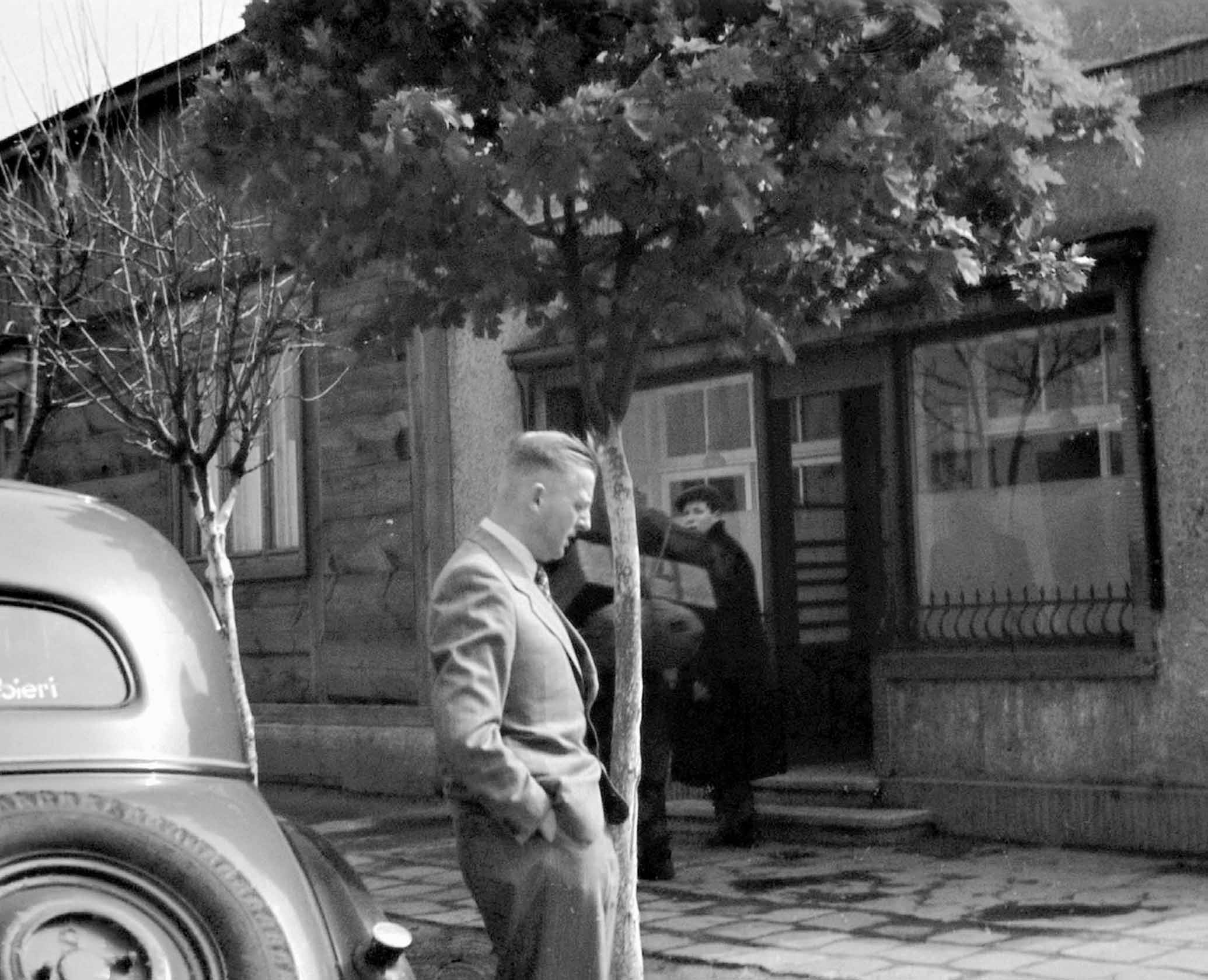
Hans Biebow stands next to a car in a street in the Łódź ghetto. (USHMM: Robert Abrams)
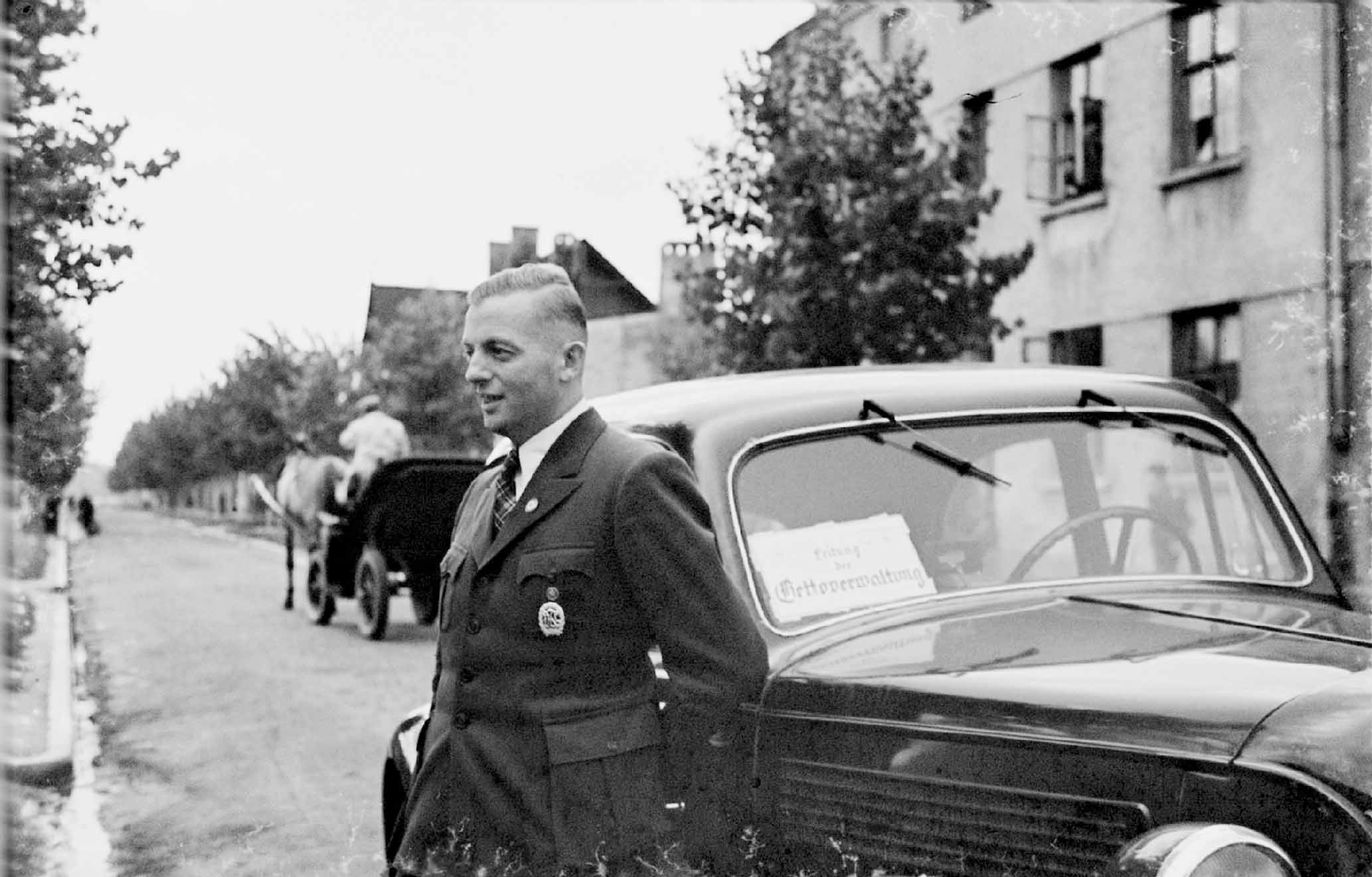
Hans Biebow, Nazi administrator of the Łódź ghetto, poses in front of a car. (USHMM: Robert Abrams)
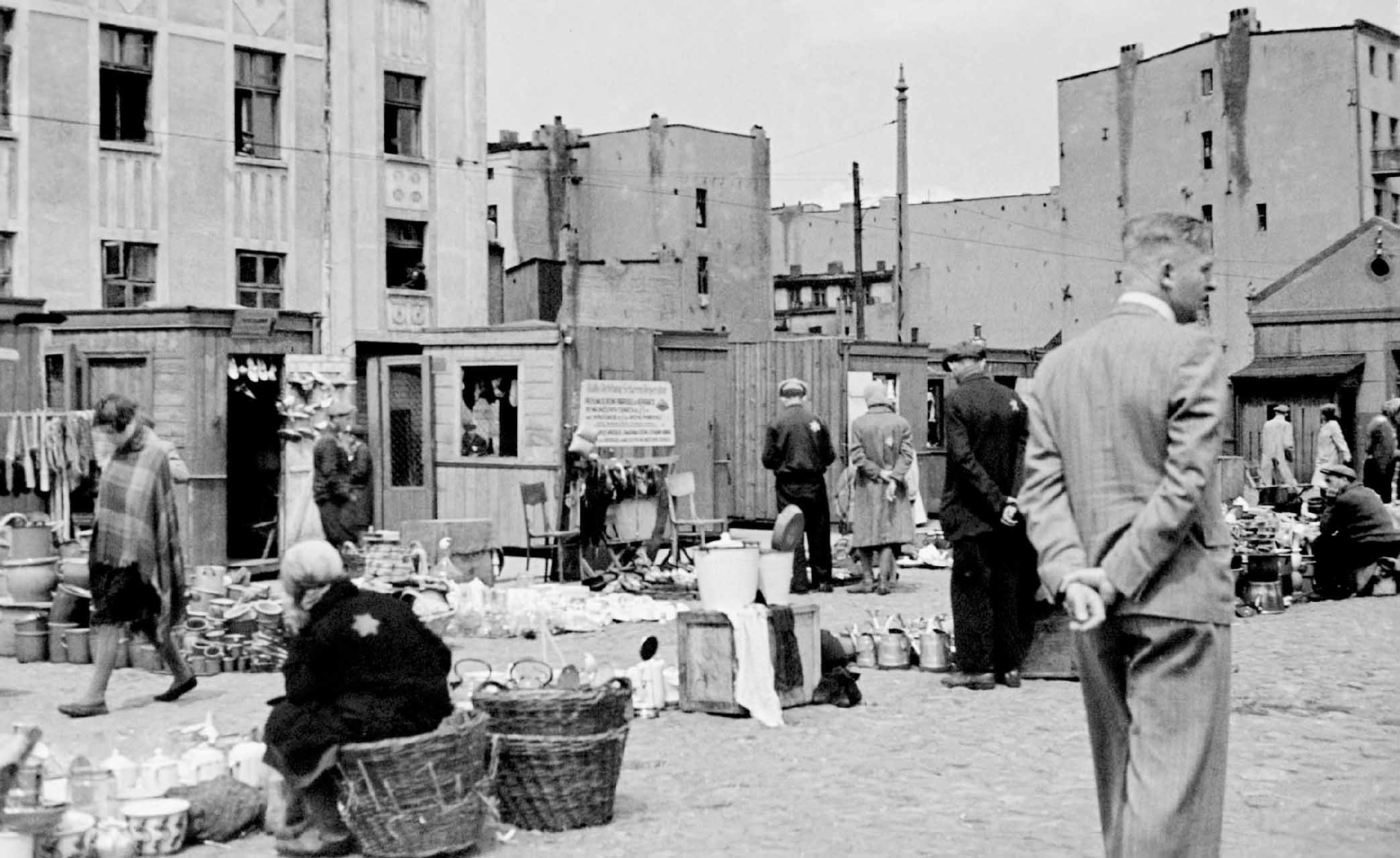
Hans Biebow oversees the running of the ghetto. He can be seen standing at a Jewish market. (USHMM: Robert Abrams)
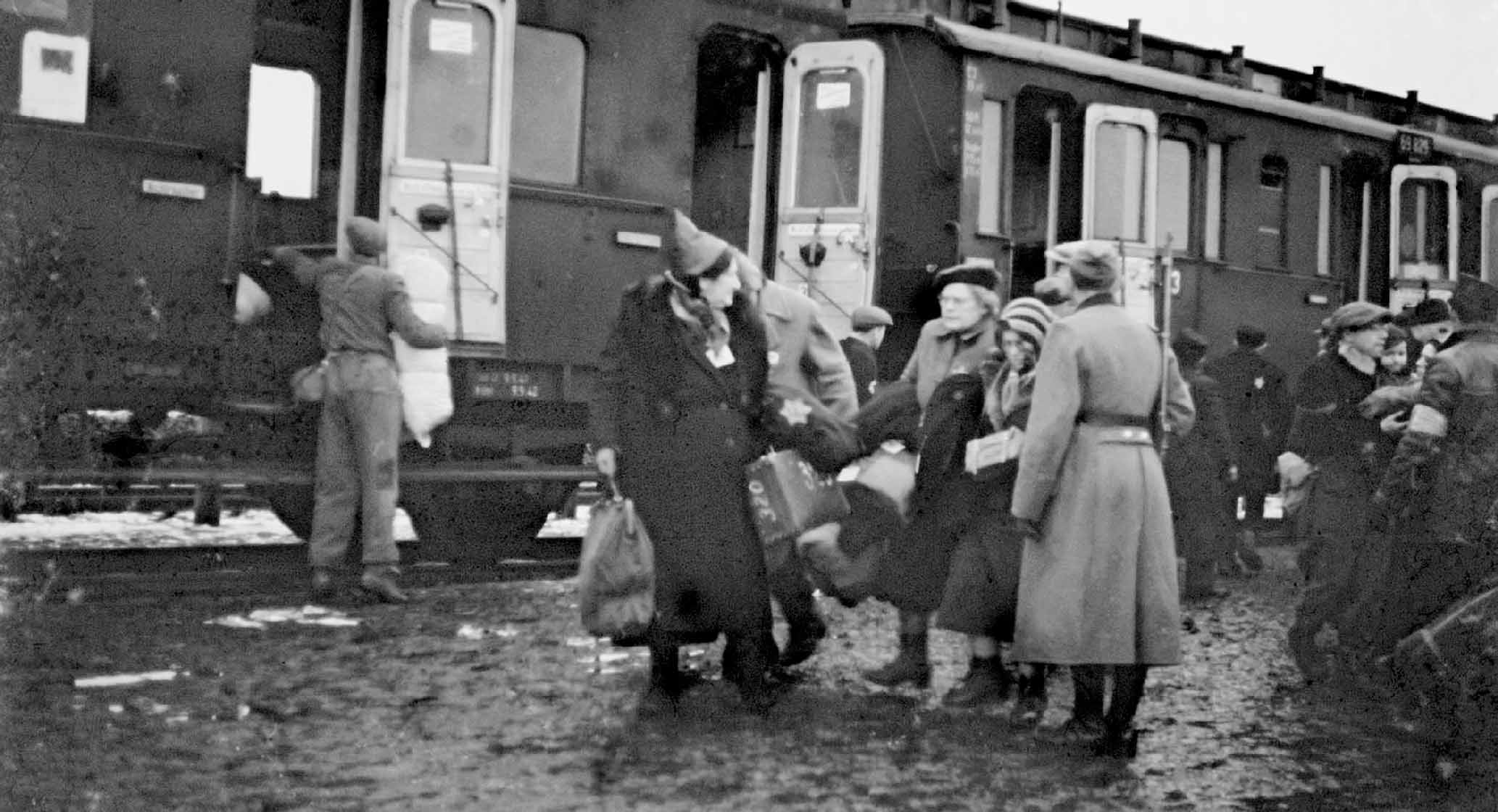
This photograph shows deportees arriving by train at the Radogoszcz station in Marysin, destined for the Łódź ghetto. They were unloaded off these trains and marched in columns to the ghetto. Often they brought small bundles of belongings with them. (USHMM: Robert Abrams)
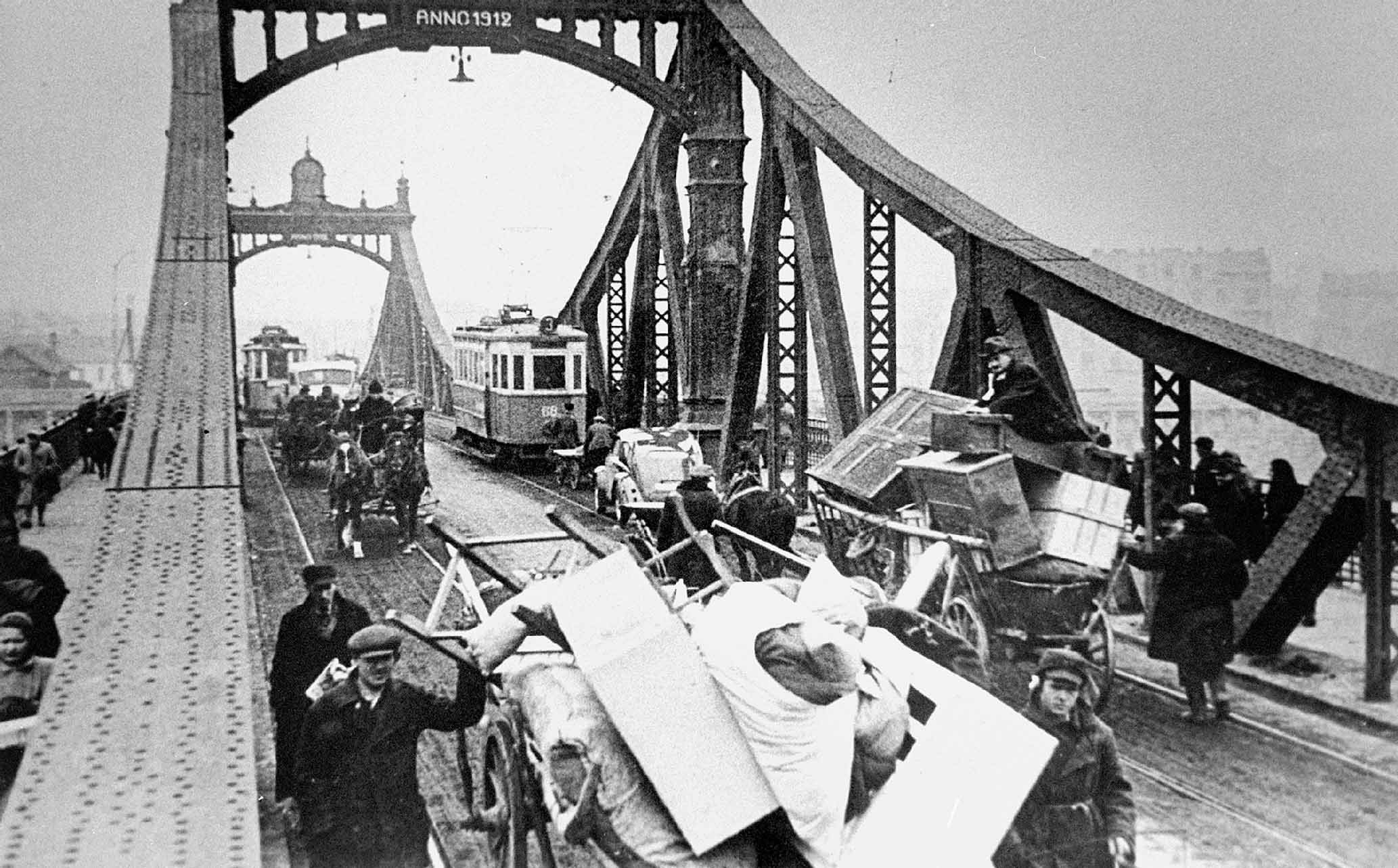
Jews who are being forced to relocate to the Krakόw ghetto in 1940 can be seen moving their belongings in carts and horse-drawn wagons across a bridge over the Vistula. (USHMM: Zydowski Instytut Historyczny imienia Emanuela Ringelbluma)
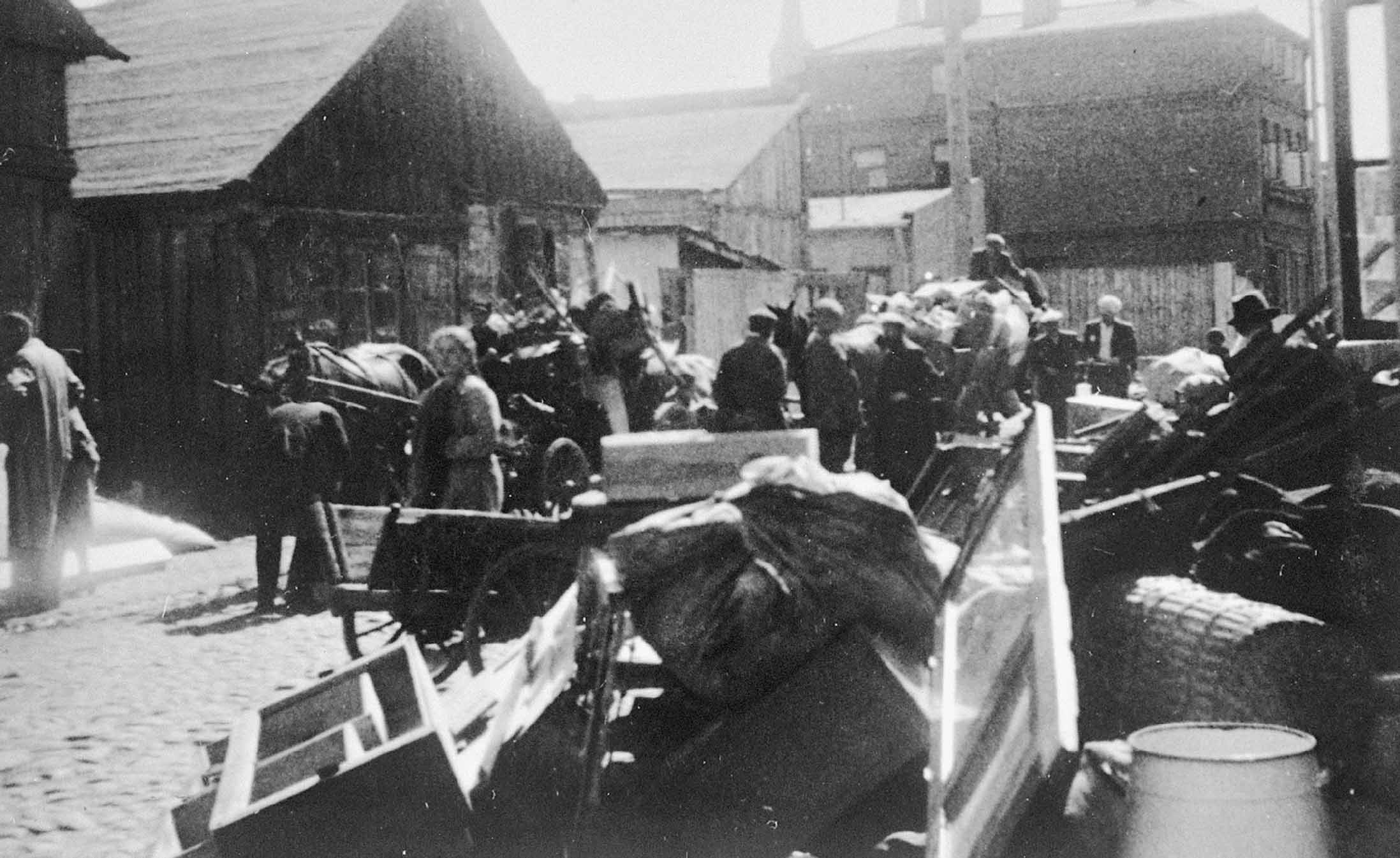
Jews move their belongings to the Kutno ghetto. More than 7,000 were crowded into the grounds of the factory, several buildings of which had been bombed, forcing many of the new tenants to make outdoor living arrangements. The Germans surrounded the area with barbed wire and watchtowers. (USHMM: Instytut Pamieci Narodowej)
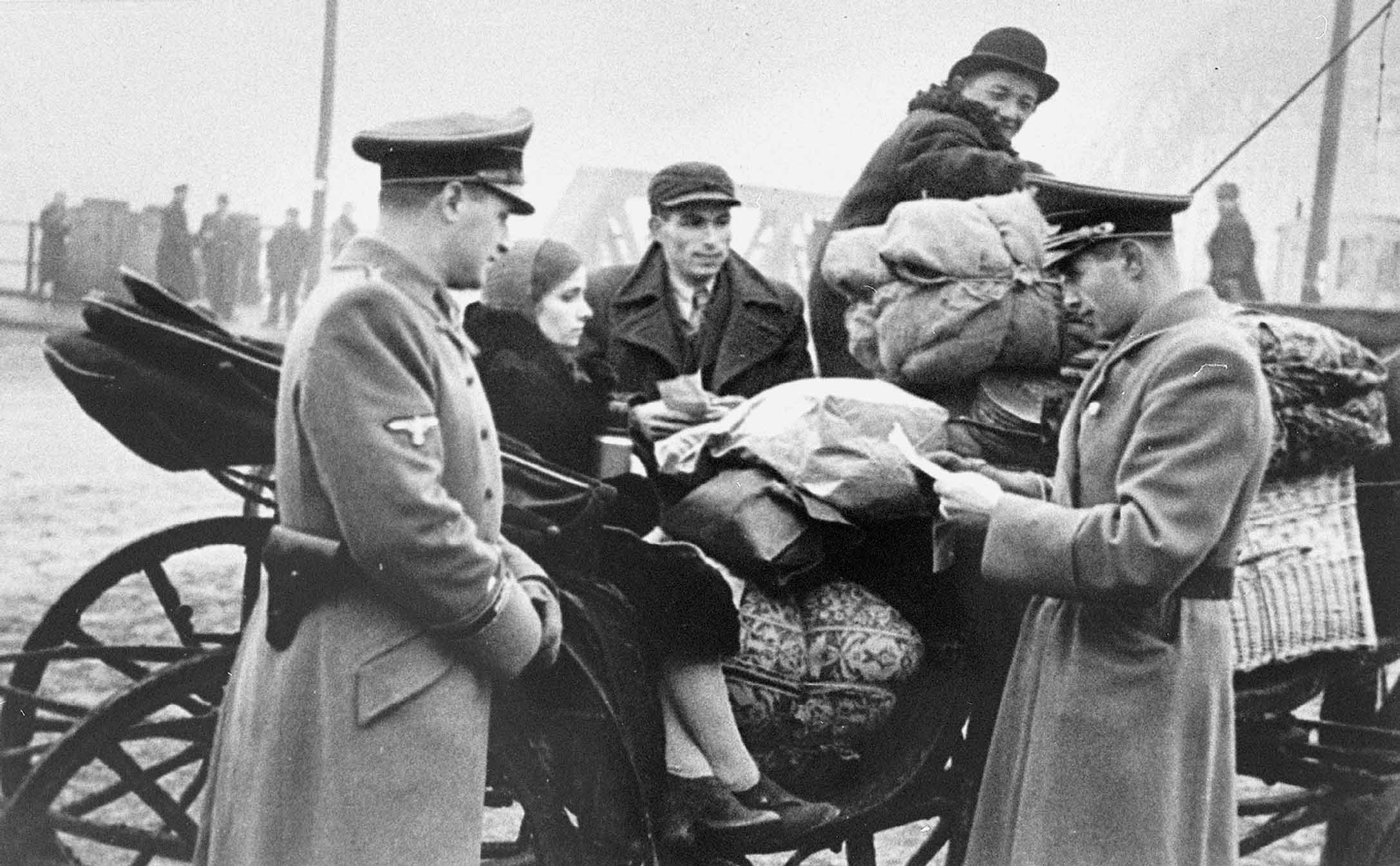
A German officer checks the papers of Jews moving into the Krakόw ghetto. (USHMM: Archiwum Panstwowe w Krakόwie)
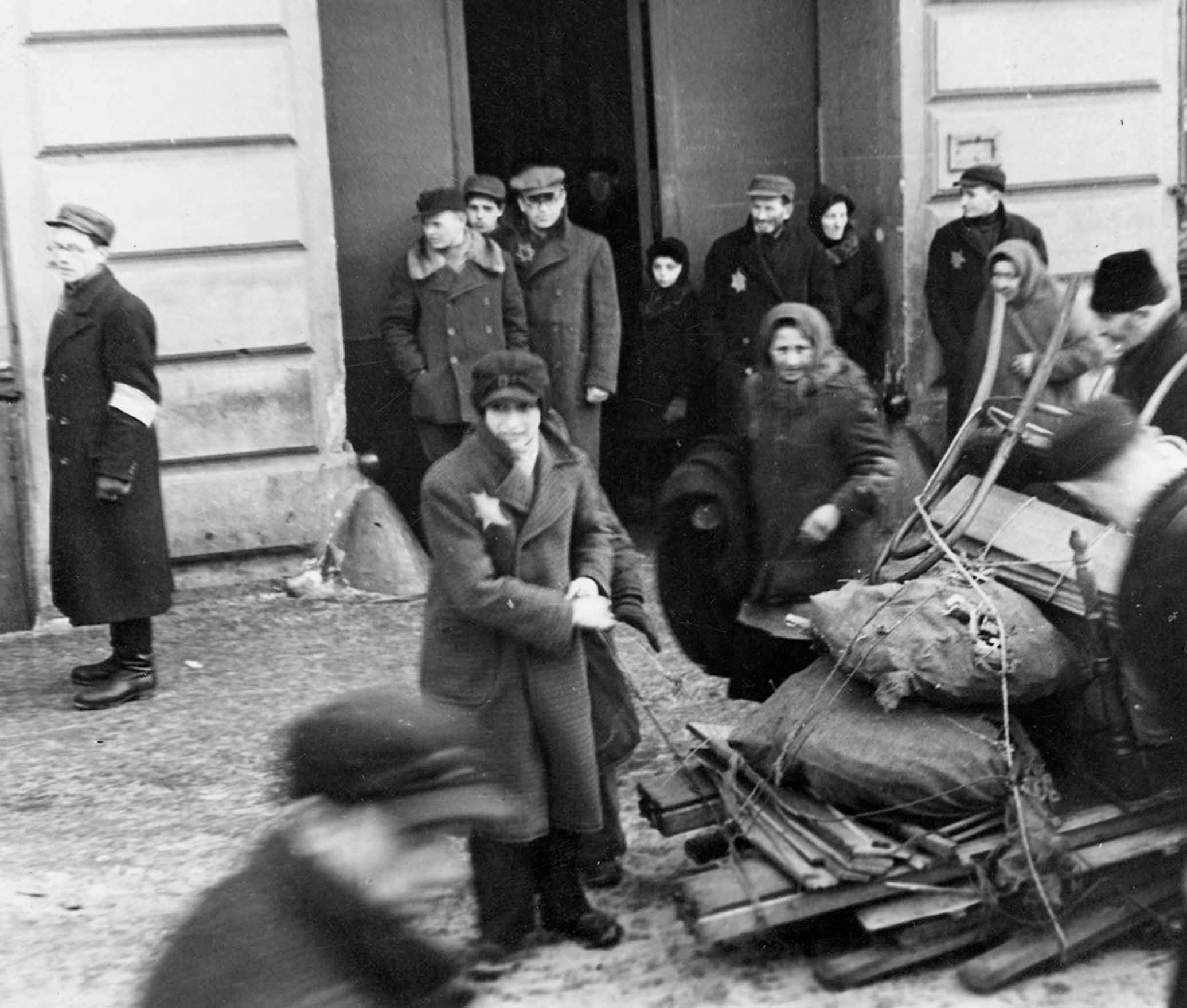
Jews haul their belongings into the Łódź ghetto in 1940. (USHMM: Moshe Zilbar)
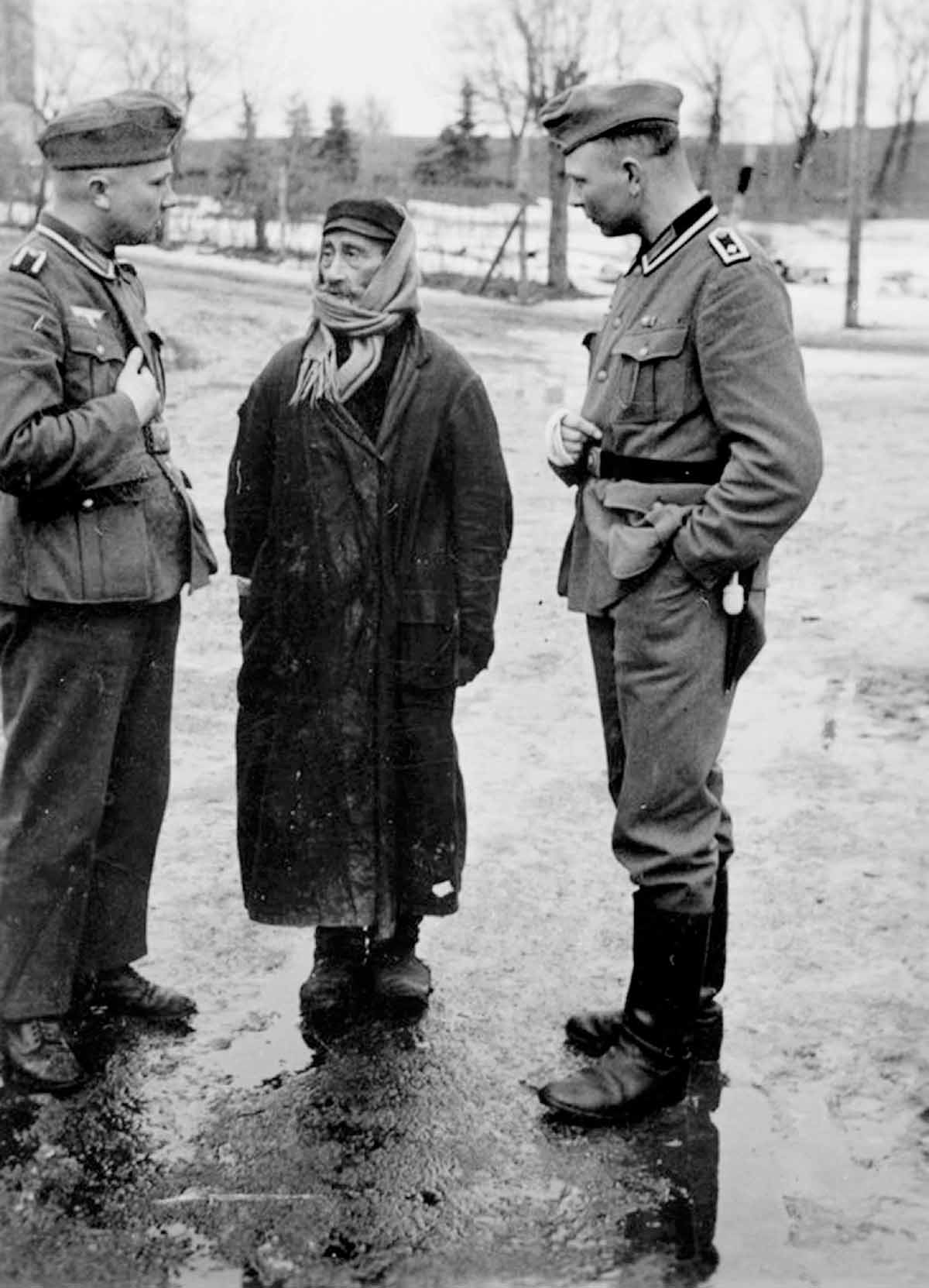
Two German regulars interrogate a bearded Polish Jew. (USHMM: Leonard Lauder)
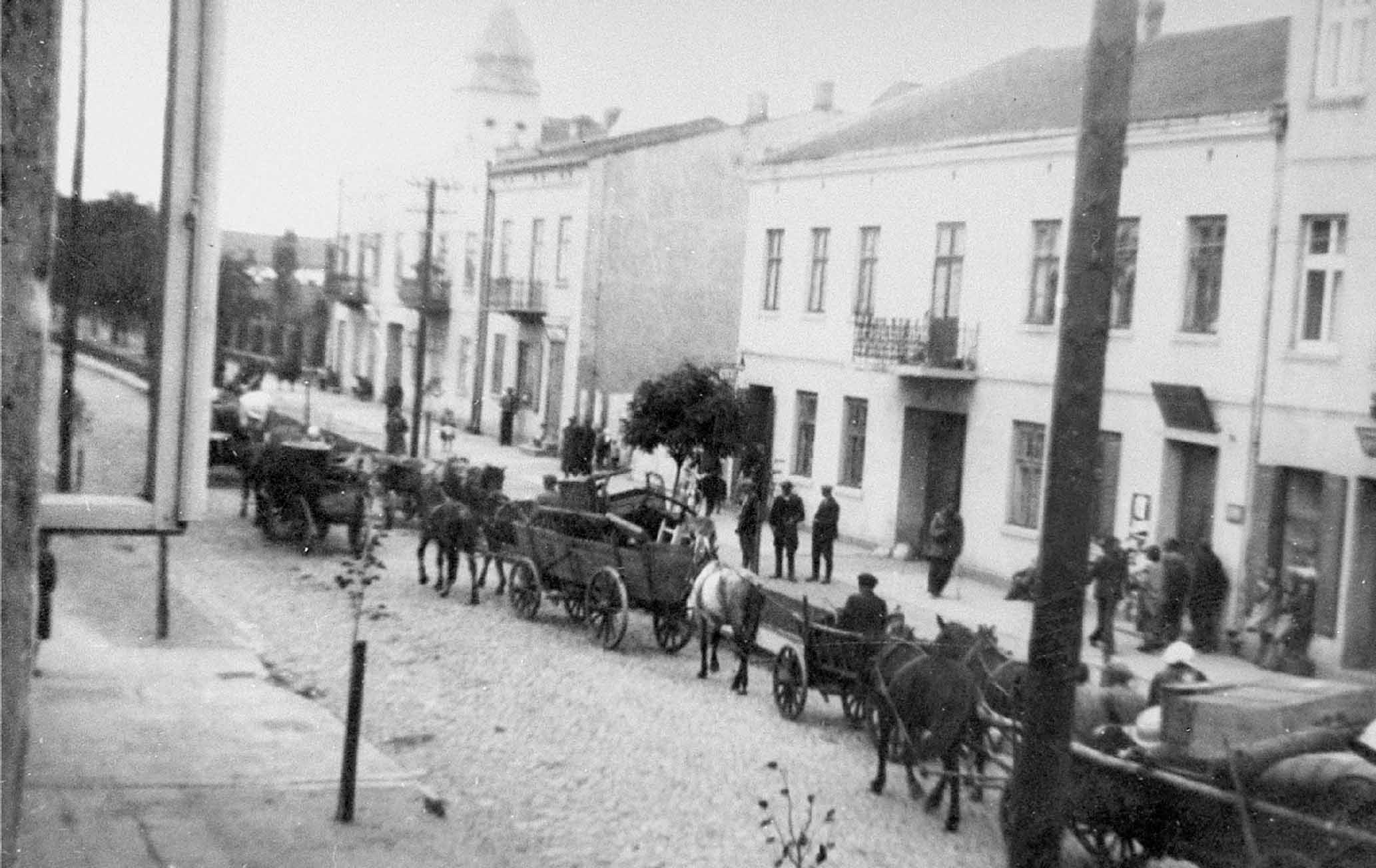
Horse-drawn wagons along Kosciuszko Street in Belchatow during the relocation of Jews to the ghetto. Half of the population of the town was Jewish. The ghetto operated until August 1942 when it was liquidated. The occupants were sent either to the Łódź ghetto or directly to the Chełmno concentration camp. (USHMM: County Court of Belchatow)
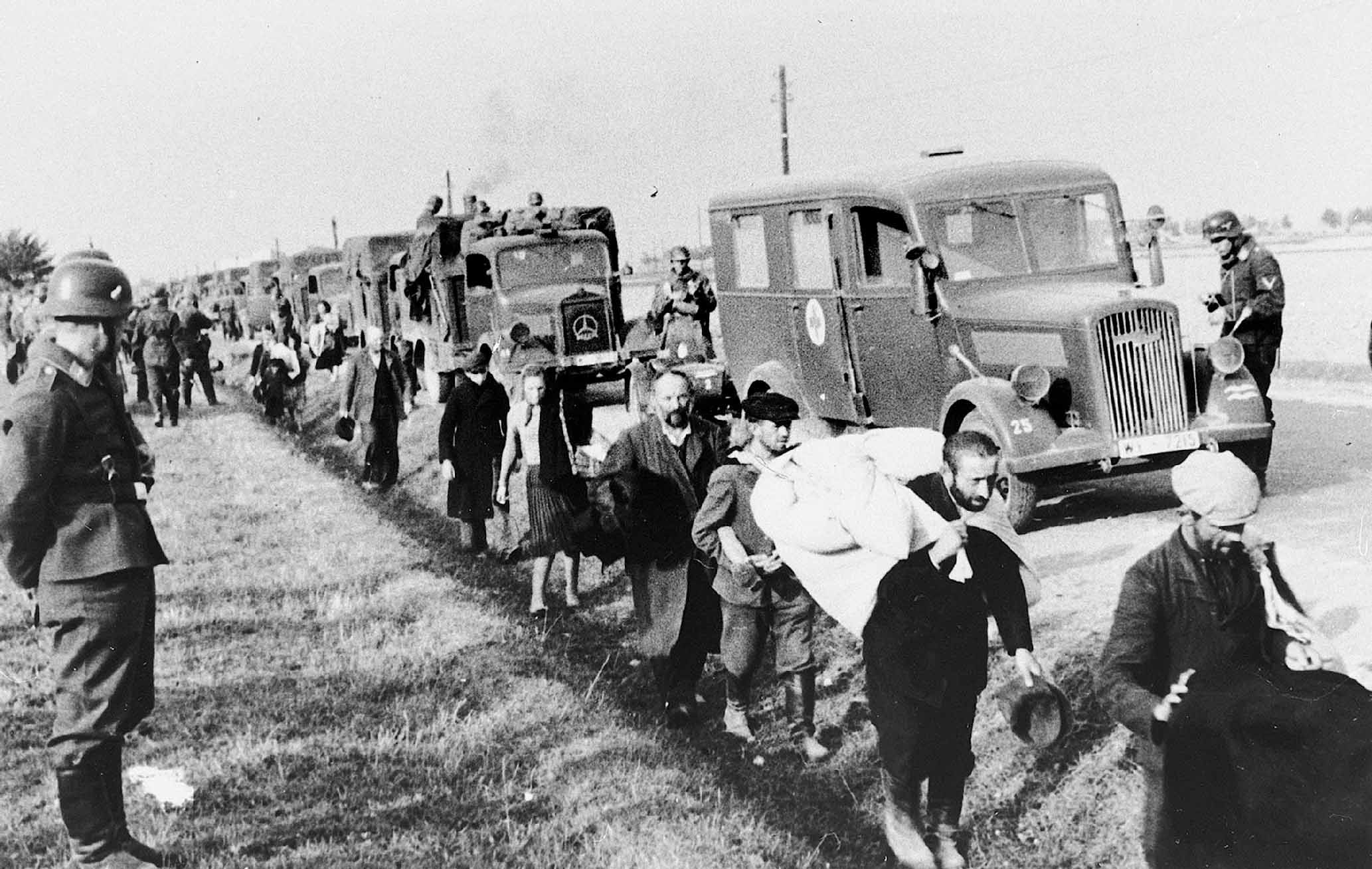
German troops supervise a column of (probably Polish) Jews marching by the side of a road in a forced resettlement action. These Jews would be relocated to a ghetto. (USHMM: Michael O’Hara)
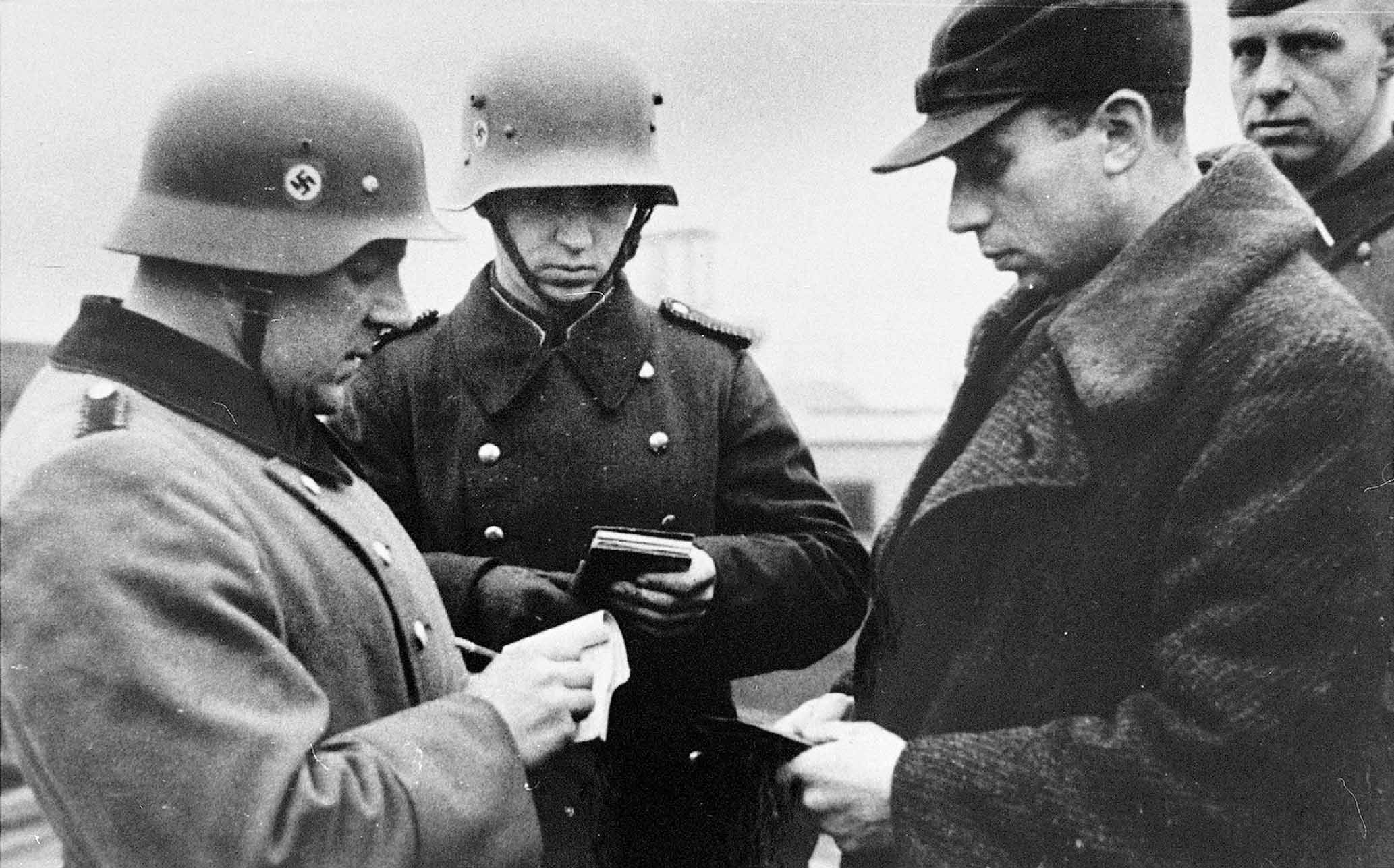
German police check the identification papers of a Jew in the streets of Krakόw, more than likely before the establishment of the Krakόw ghetto in March 1941. The ghetto was to be set up in the Jewish quarter in Poόdgorze, a suburb of the city. All non-Jewish residents of the area were required to relocate in other districts of the city by 20 March 1941. (USHMM: Archiwum Panstwowe w Krakόwie)
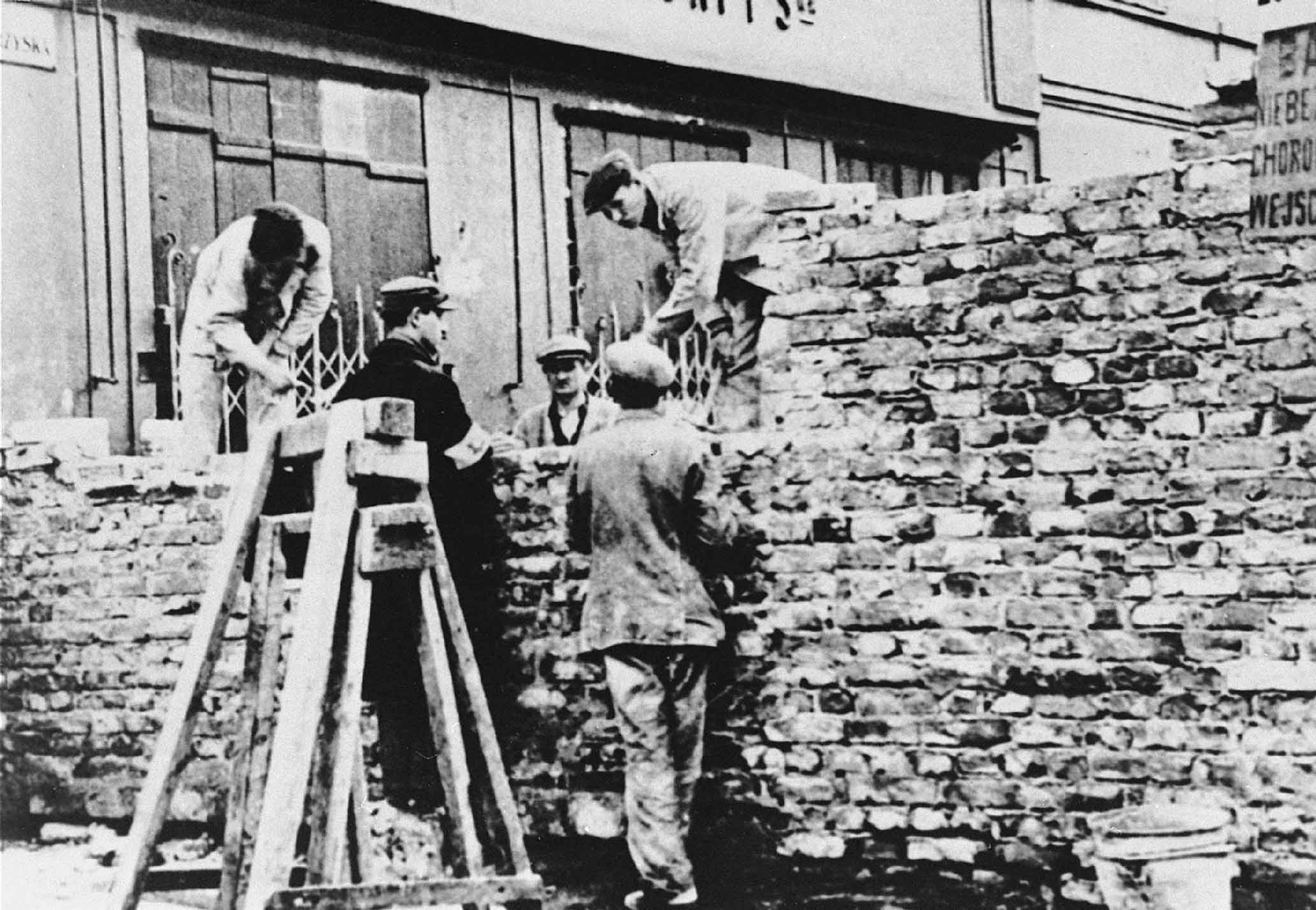
Polish and Jewish labourers construct a section of the wall that separated the Warsaw ghetto from the rest of the city. On the orders of Warsaw District Governor Ludwig Fischer, construction of the ghetto wall began on 1 April 1940. The wall would completely encircle the ghetto and segregate the inhabitants from the inhabitants of Warsaw. By 16 October 1940 the ghetto was officially in operation and imprisoned 375,000 to 400,000 Jews. (USHMM: Leopold Page Photographic Collection)
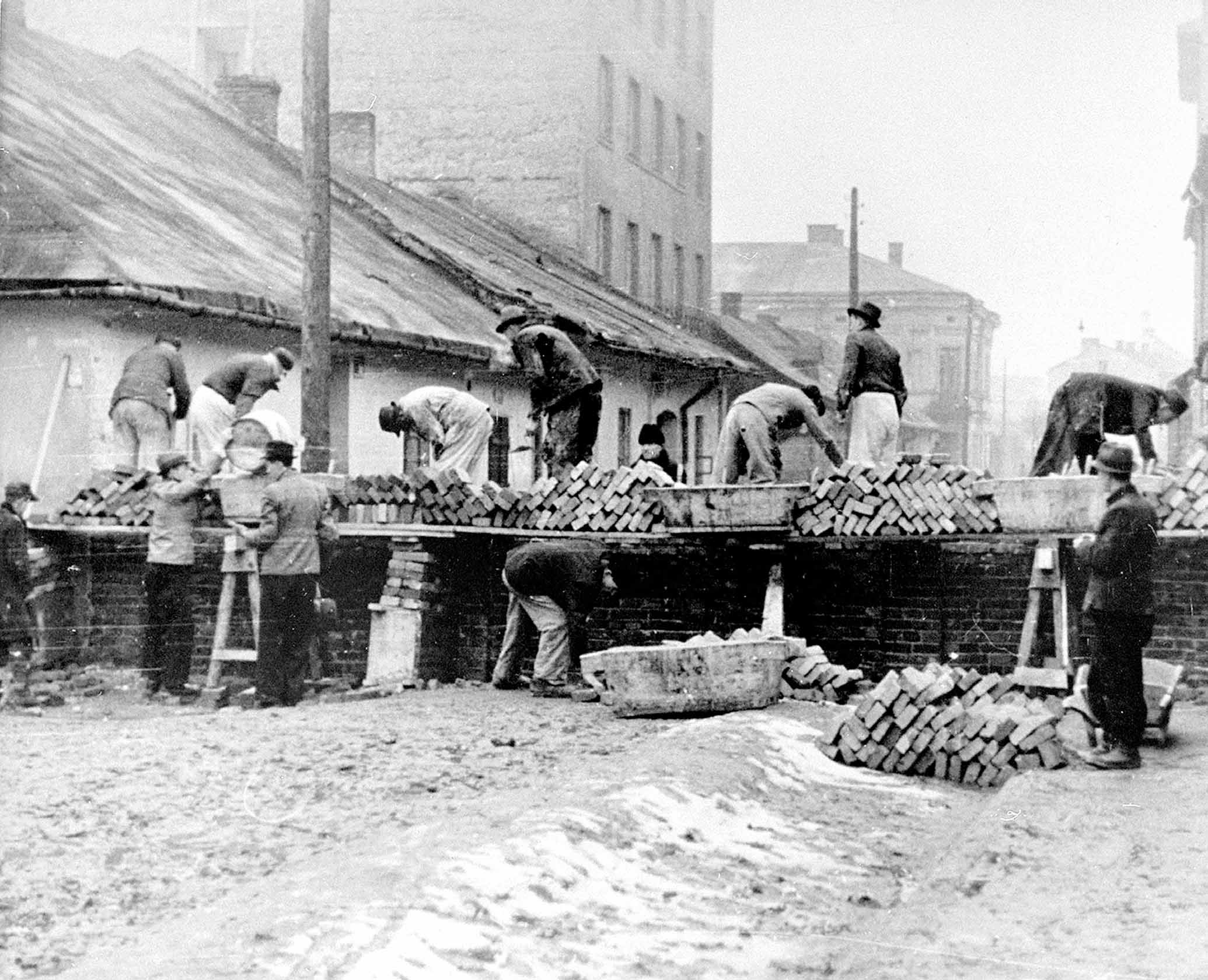
Jews are forced to construct the wall around the newly erected Krakόw ghetto. Many of these walls contained brick panels in the shape of tombstones, which appealed to the sadistic German authorities overseeing the ghetto operation. All windows and doors that opened onto the ‘Aryan’ side were ordered to be bricked up. There were four main entrances that allowed traffic to pass in and out. (USHMM: Instytut Pamieci Narodowej)

Polish labourers seal off the doors and windows of buildings on the outer border of the Krakόw ghetto. (USHMM: Instytut Pamieci Narodowej)
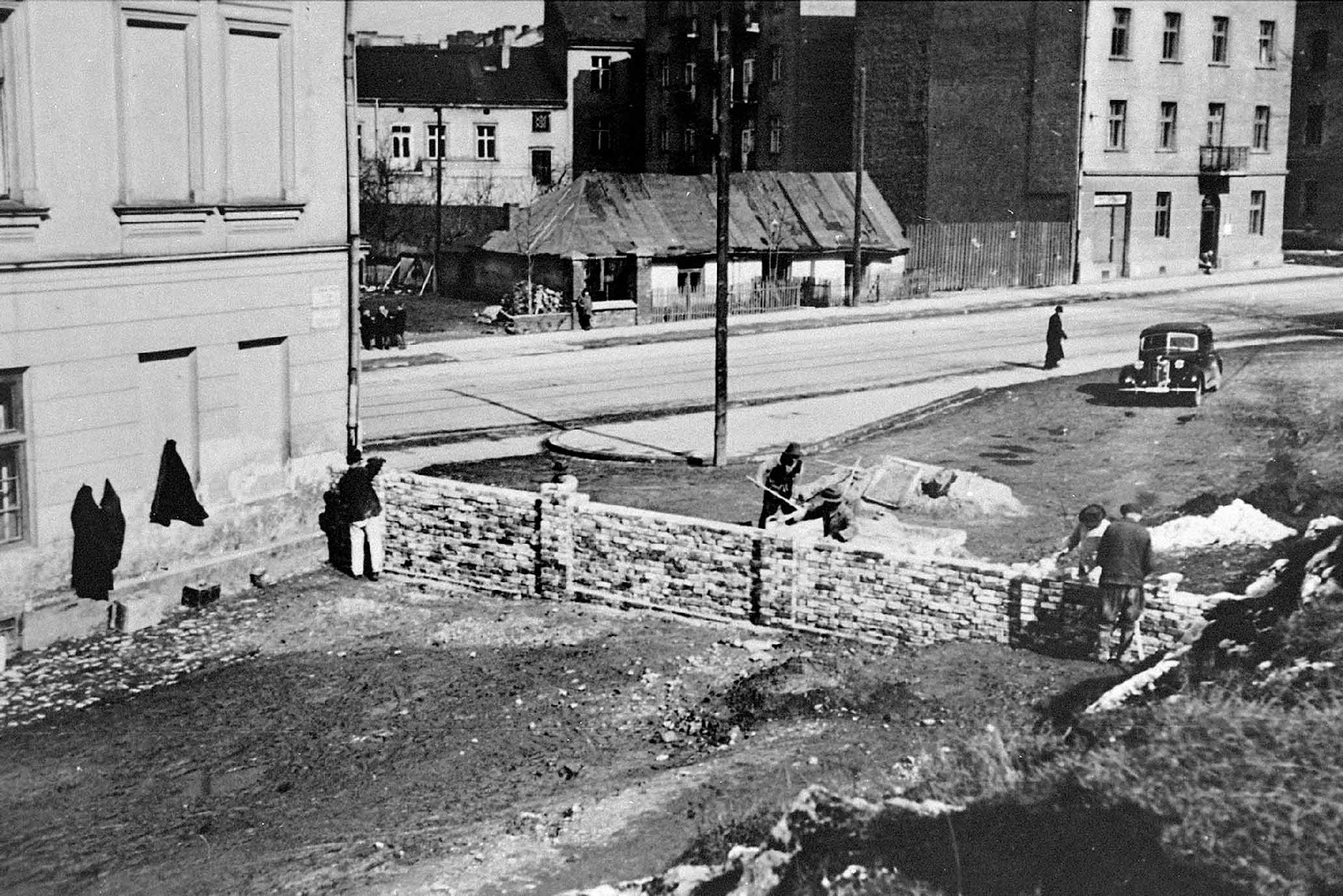
Jewish workers are forced to construct the wall around the Krakόw ghetto. The ghetto district comprised 30 streets and 320 residential buildings. When first formed it was populated by some 16,000 Jews. (USHMM: Instytut Pamieci Narodowej)
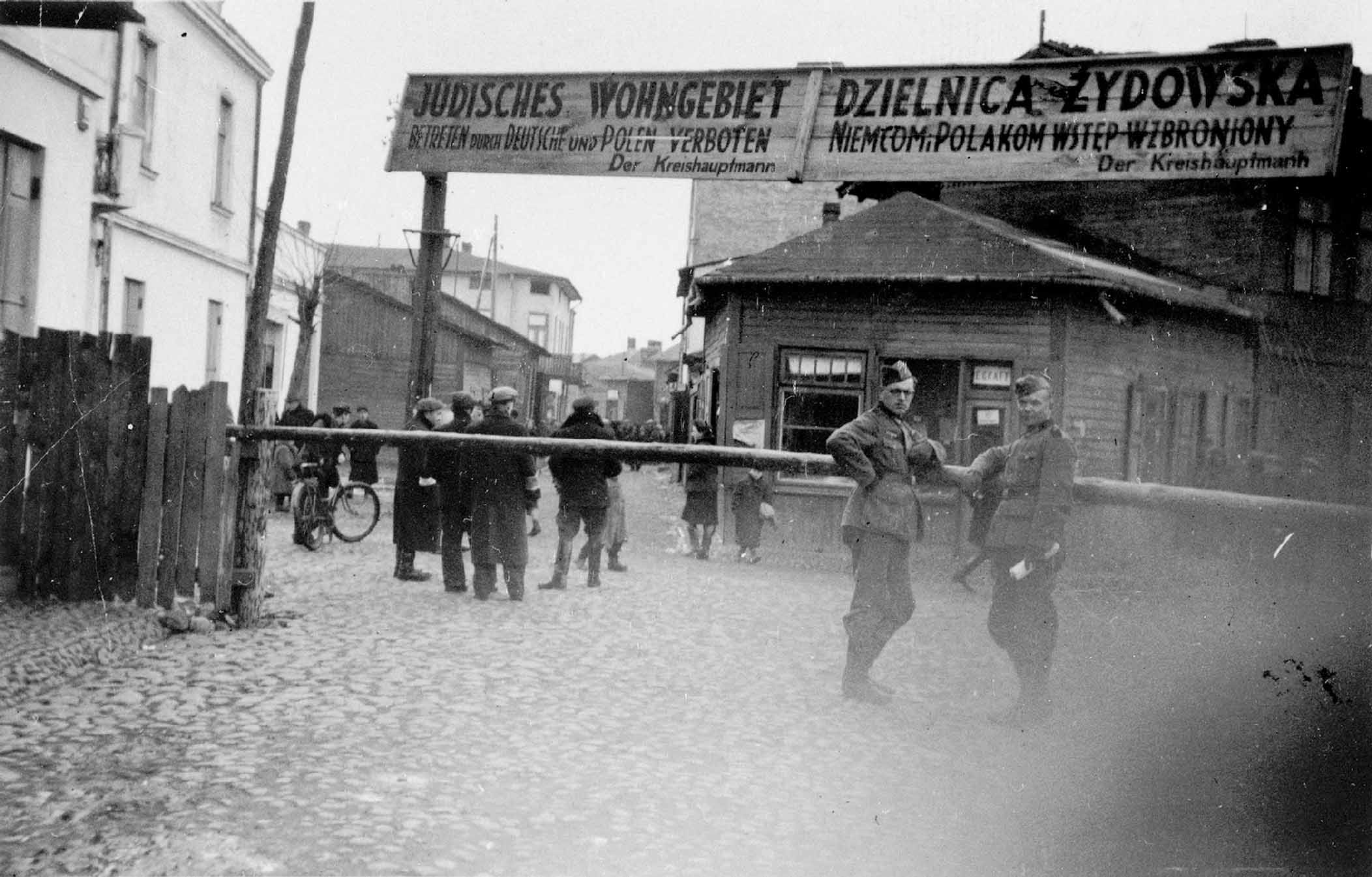
Two German soldiers pose at the entrance to an unidentified ghetto in Poland. This photograph was more than likely taken between 1940 and 1941 when most of the Polish ghettos across the General Government were being constructed. (USHMM: Harry Lore)
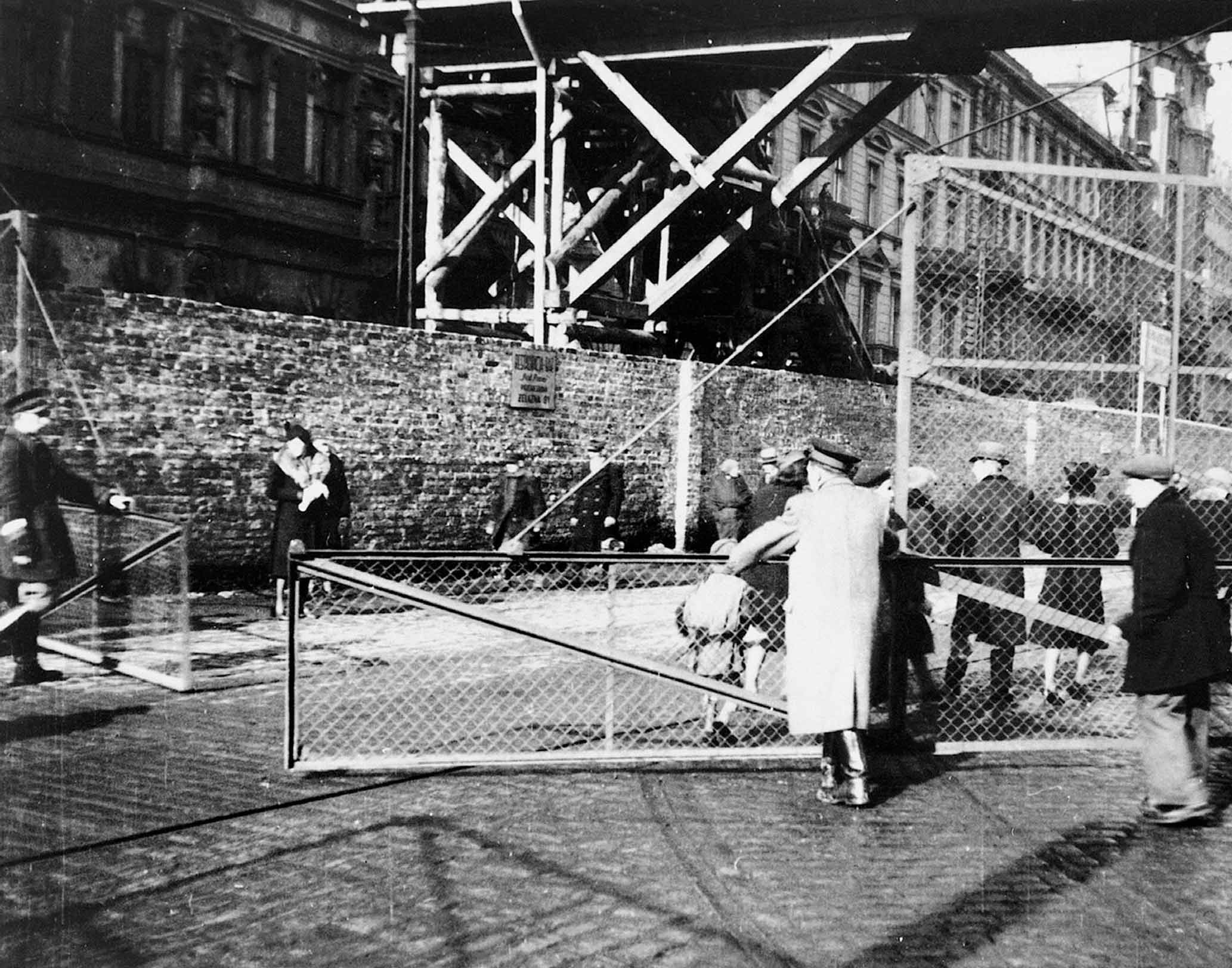
Jewish police open the gates to a street that divides the Warsaw ghetto. Overhead, a pedestrian bridge spans the two sections of the ghetto. This photograph is one of a series of photographs taken by an unidentified German soldier in 1942. (USHMM: Simon Adelman)
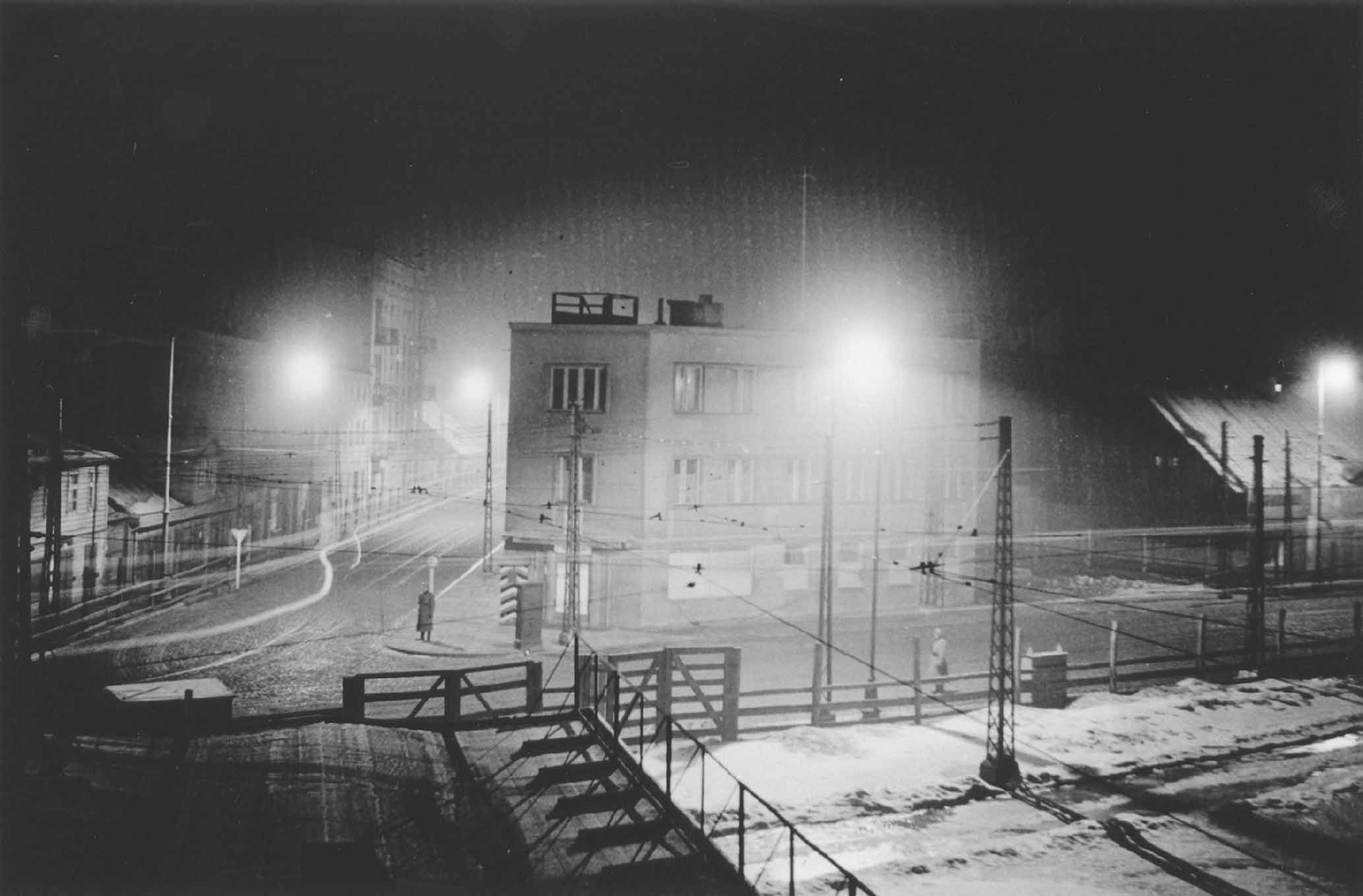
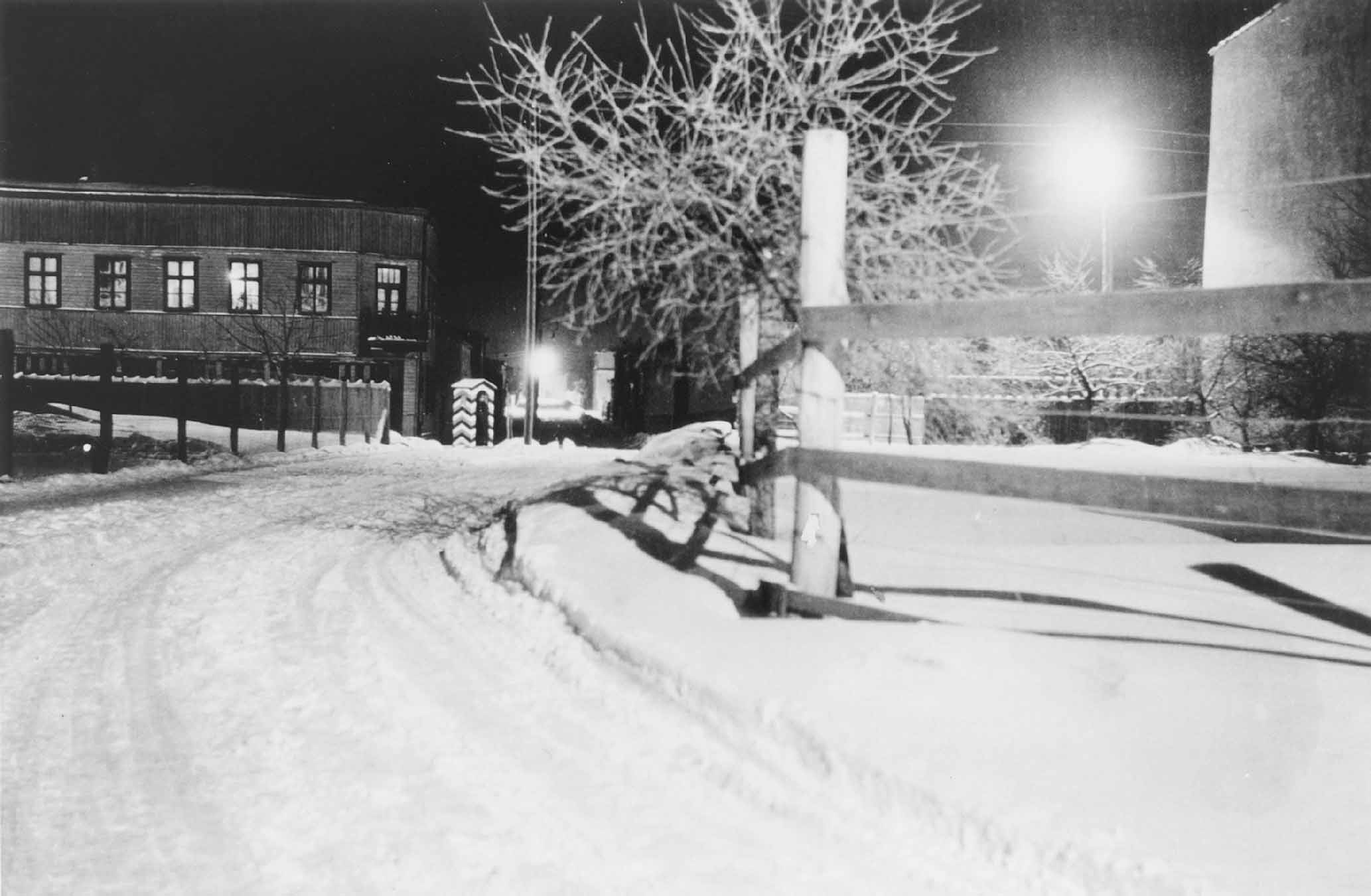
Two photographs taken by a member of Police Battalion 101, one showing the guards from the battalion guarding the perimeter of the Łódź ghetto during the night, the other showing just the perimeter area and one of the guard sentry boxes. The duties of this battalion consisted of controlling civilian populations of the conquered or ‘colonised countries’ to assist the Einsatzgruppen murder squads as they advanced through Russia murdering Jews and elements they considered undesirable to the Reich. They also rounded up Jews and deported them to the ghettos, and guarded them. On 28 November 1940 the police battalion was redeployed to guard the perimeter of the Łódź ghetto. Later during the liquidation of the ghetto system across the General Government in 1942 they were responsible for removing the Jews, supporting the operations to send them to labour or death camps, and murdering them in wholesale executions in forests and fields. (USHMM: Michael O’Hara)
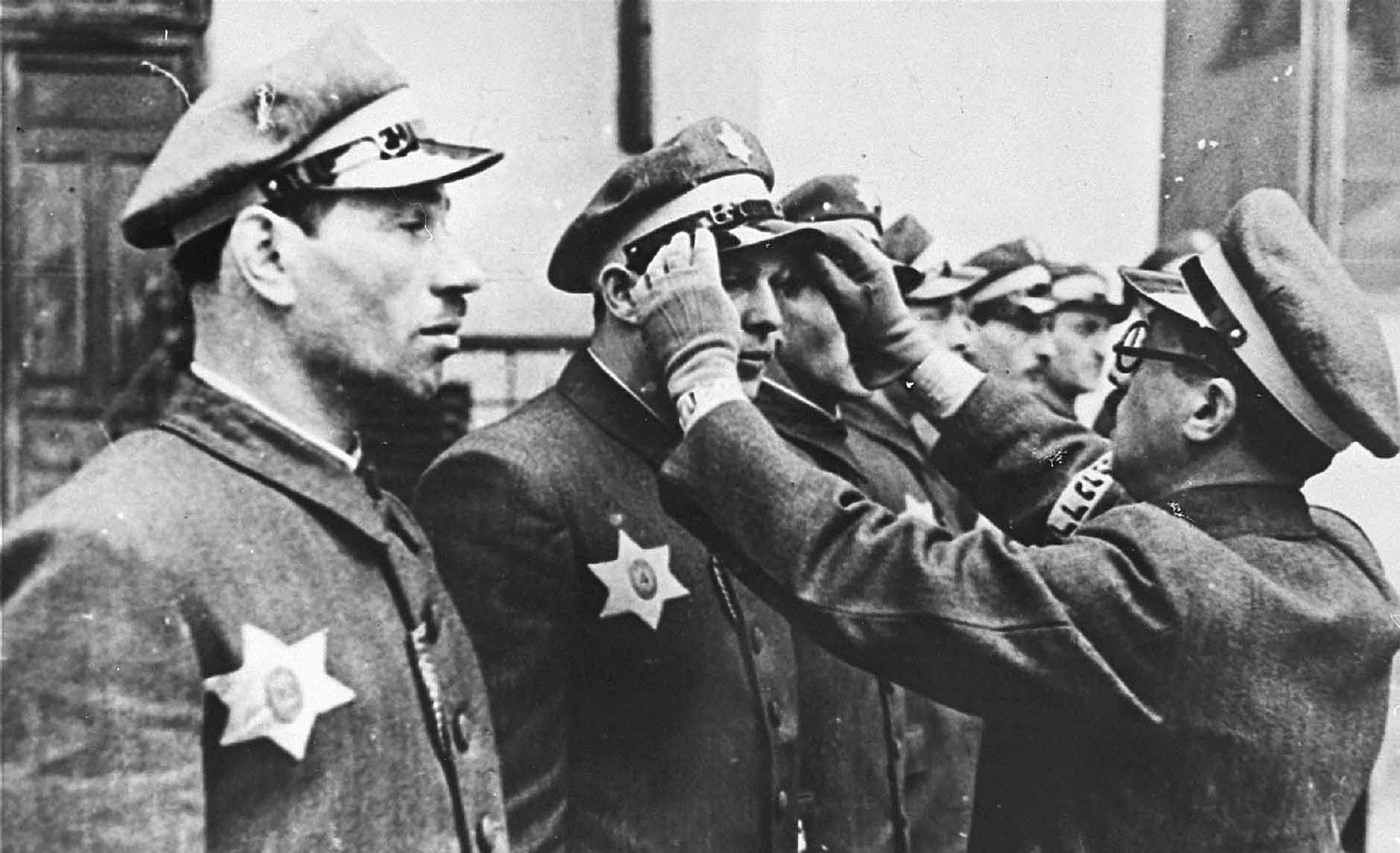
Taken in July 1941, this shows Symche Spira, the senior officer of the Krakόw ghetto police (Ordnungsdienst) straightening the cap of one of his men during roll call. Members of the Ordnungsdienst in Krakόw wore a uniform with an armband with ‘Ordnungsdienst’ written in Hebrew. The badges were made in the shape of the Star of David surrounding an oval that gave the officer’s number. (USHMM: Raphael Aronson)
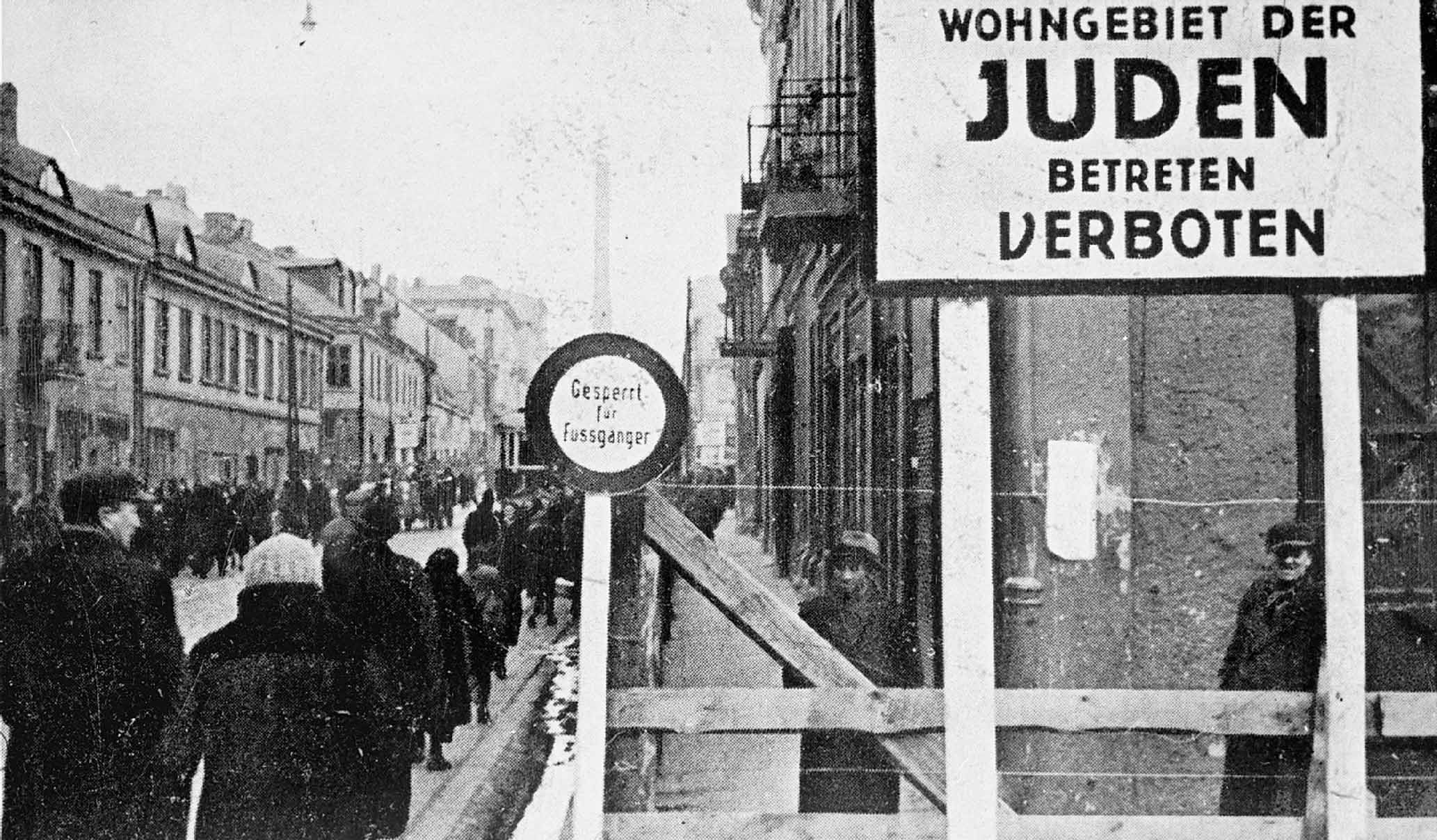
Postcard from the Łódź ghetto showing the entrance and a sign forbidding entrance to non-Jews. (USHMM: Antonii Marianowicz)
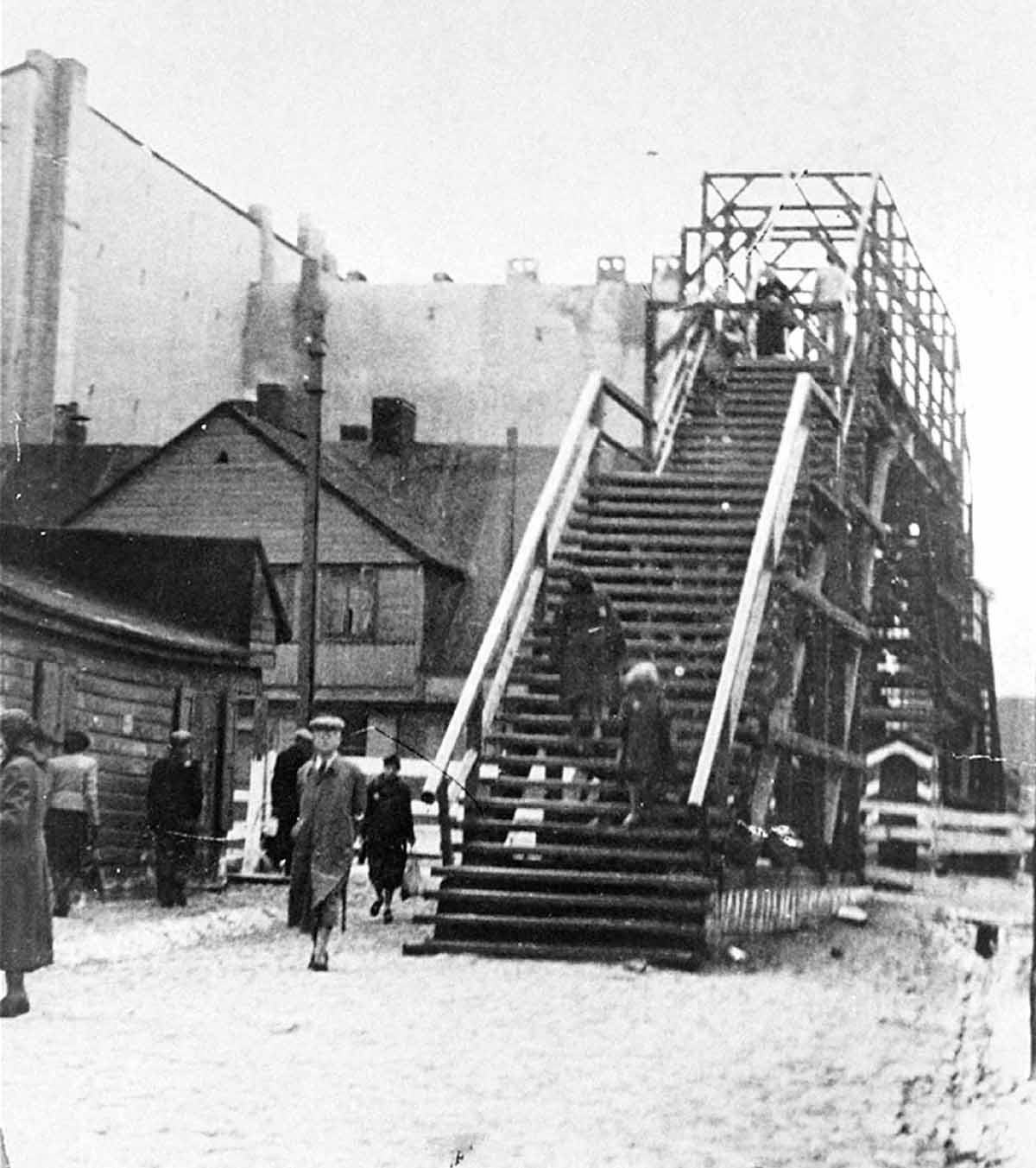
View of Łódź ghetto residents climbing the staircase to cross one of the pedestrian bridges. The Yiddish inscription on the back of the photo reads, ‘The ghetto through the bridge on Marynarska Street via Aleksandrov Street – Fayfer’s Alley.’ (USHMM: Abram Zelig)